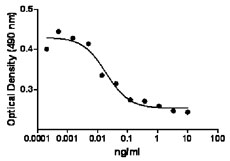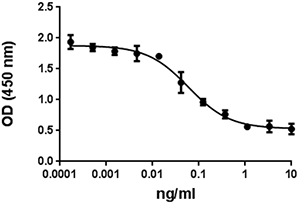- Regulatory Status
- RUO
- Other Names
- IFN-alpha 2B, IFN-alphaA, IFNA2, IFNA2B
- Ave. Rating
- Submit a Review
- Product Citations
- publications
Interferons are divided into type I, II, and III. Type I IFNs (IFN-α and IFN-β) are most abundant in number, distribution, and expression. Also, they are highly conserved among mammals in both structure and function. IFN-α2 has been used in the treatment of cancer such as bladder cancer, hepatocellular carcinoma, and leukemia. IFN-α2 augments the suppressed immune functions in patients with head and neck squamous cell carcinoma (HNSCC). IFN-α2 initiated T and NK cell mediated cytotoxicity of tumor cells through IFNγ dependent and independent mechanisms. IFN-α2 enhances suppressed T cell cytotoxicity by stimulation of the perforin-granzyme B system (IFNγ dependent). Also, IFN-α2 induces the expression of perforin-granzyme B in NK cells (NK mediated cytotoxicity, IFNγ independent). In a preliminary study, IFN-α2 appears to be an effective immunostimulator and impacts the clinical outcome in tongue squamous cell carcinoma patients. IFN-α had been used in the treatment of chronic hepatitis C (CHC); nevertheless, IFN-α is relatively unstable and requires frequent parenteral administration. Pegylation of IFN-α, polyethylene glycol (PEG)-IFN-α, reduces in vitro activity but increase the stability and plasma half-life of IFN-α; therefore, PEG-IFN-α has replaced IFN-α in CHC treatment.
Product DetailsProduct Details
- Source
- Human IFN-α2, amino acids Cys24-Glu188 (Accession# NM_000605) was expressed in E.coli.
- Molecular Mass
- The 166 amino acid recombinant protein has a predicted molecular mass of approximately 19.4 kD. The DTT-reduced and non-reduced proteins migrate at approximately 20 kD and 18 kD respectively by SDS-PAGE. The N-terminal amino acid is Met.
- Purity
- >95%, as determined by Coomassie stained SDS-PAGE.
- Formulation
- 0.22 µm filtered protein solution is in PBS, pH 7.2.
- Endotoxin Level
- Less than 0.01 ng per µg cytokine as determined by the LAL method.
- Concentration
- 10 and 25 µg sizes are bottled at 200 µg/mL. 100 µg size and larger sizes are lot-specific and bottled at the concentration indicated on the vial. To obtain lot-specific concentration and expiration, please enter the lot number in our Certificate of Analysis online tool.
- Storage & Handling
- Unopened vial can be stored between 2°C and 8°C for up to 2 weeks, at -20°C for up to six months, or at -70°C or colder until the expiration date. For maximum results, quick spin vial prior to opening. The protein can be aliquoted and stored at -20°C or colder. Stock solutions can also be prepared at 50 - 100 µg/mL in appropriate sterile buffer, carrier protein such as 0.2 - 1% BSA or HSA can be added when preparing the stock solution. Aliquots can be stored between 2°C and 8°C for up to one week and stored at -20°C or colder for up to 3 months. Avoid repeated freeze/thaw cycles.
- Activity
- Specific activity is 1.86 x 108 units/mg, as determined in a cytopathic effect inhibition assay using EMC virus on A549 cells.
- Application
-
Bioassay
- Application Notes
-
This recombinant protein is encoded by the human IFN-a2B isoform.
BioLegend carrier-free recombinant proteins provided in liquid format are shipped on blue-ice. Our comparison testing data indicates that when handled and stored as recommended, the liquid format has equal or better stability and shelf-life compared to commercially available lyophilized proteins after reconstitution. Our liquid proteins are verified in-house to maintain activity after shipping on blue ice and are backed by our 100% satisfaction guarantee. If you have any concerns, contact us at tech@biolegend.com. - Product Citations
-
Antigen Details
- Distribution
-
IFN-α is ubiquitously expressed.
- Function
- IFN-α stimulates cytotoxic T lymphocytes and natural killer cell function. IFN-α has immunomodulatory and antiviral properties. IFNα2a induces CXCL10 in human microvascular endothelial cells and pulmonary artery smooth muscle cells. It is induced by viral infection.
- Interaction
- Varieties of cells express the IFNα receptor (IFNAR).
- Ligand/Receptor
- IFNAR complex has two components, IFNAR1 and IFNAR2.
- Biology Area
- Immunology, Innate Immunity
- Molecular Family
- Cytokines/Chemokines
- Antigen References
-
1. Bose A and Baral R. 2007. Immunol. Lett. 108:68.
2. Zhao W, et al. 2008. J. Immunol. 180:5483.
3. Badiger R, et al. 2012. Plos One 7:e46779.
4. Aghemo A, et al. 2010. Nat. Rev. Gastroenterol. Hepatol. 7:485.
5. Becker-Merok A, et al. 2013. Lupus 22:155.
6. Mukherjee KK, et al. 2012. Indian J. Med. Res. 136:54. - Gene ID
- 3440 View all products for this Gene ID
- UniProt
- View information about IFN-alpha2 on UniProt.org
Related Pages & Pathways
Pages
Related FAQs
- Why choose BioLegend recombinant proteins?
-
• Each lot of product is quality-tested for bioactivity as indicated on the data sheet.
• Greater than 95% Purity or higher, tested on every lot of product.
• 100% Satisfaction Guarantee for quality performance, stability, and consistency.
• Ready-to-use liquid format saves time and reduces challenges associated with reconstitution.
• Bulk and customization available. Contact us.
• Learn more about our Recombinant Proteins. - How does the activity of your recombinant proteins compare to competitors?
-
We quality control each and every lot of recombinant protein. Not only do we check its bioactivity, but we also compare it against other commercially available recombinant proteins. We make sure each recombinant protein’s activity is at least as good as or better than the competition’s. In order to provide you with the best possible product, we ensure that our testing process is rigorous and thorough. If you’re curious and eager to make the switch to BioLegend recombinants, contact your sales representative today!
- What is the specific activity or ED50 of my recombinant protein?
-
The specific activity range of the protein is indicated on the product datasheets. Because the exact activity values on a per unit basis can largely fluctuate depending on a number of factors, including the nature of the assay, cell density, age of cells/passage number, culture media used, and end user technique, the specific activity is best defined as a range and we guarantee the specific activity of all our lots will be within the range indicated on the datasheet. Please note this only applies to recombinants labeled for use in bioassays. ELISA standard recombinant proteins are not recommended for bioassay usage as they are not tested for these applications.
- Have your recombinants been tested for stability?
-
Our testing shows that the recombinant proteins are able to withstand room temperature for a week without losing activity. In addition the recombinant proteins were also found to withstand four cycles of freeze and thaw without losing activity.
- Does specific activity of a recombinant protein vary between lots?
-
Specific activity will vary for each lot and for the type of experiment that is done to validate it, but all passed lots will have activity within the established ED50 range for the product and we guarantee that our products will have lot-to-lot consistency. Please conduct an experiment-specific validation to find the optimal ED50 for your system.
- How do you convert activity as an ED50 in ng/ml to a specific activity in Units/mg?
-
Use formula Specific activity (Units/mg) = 10^6/ ED50 (ng/mL)
 Login / Register
Login / Register 














Follow Us